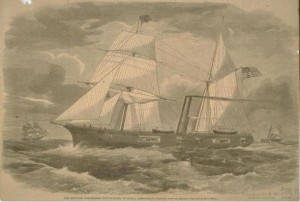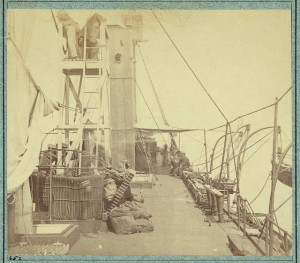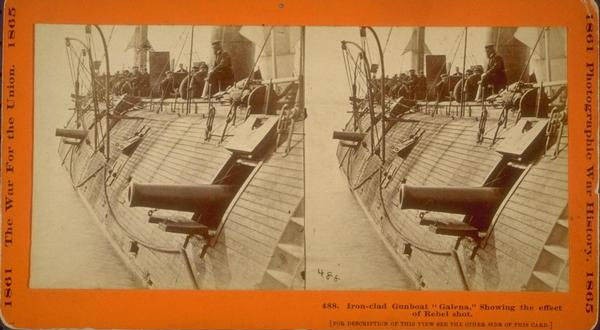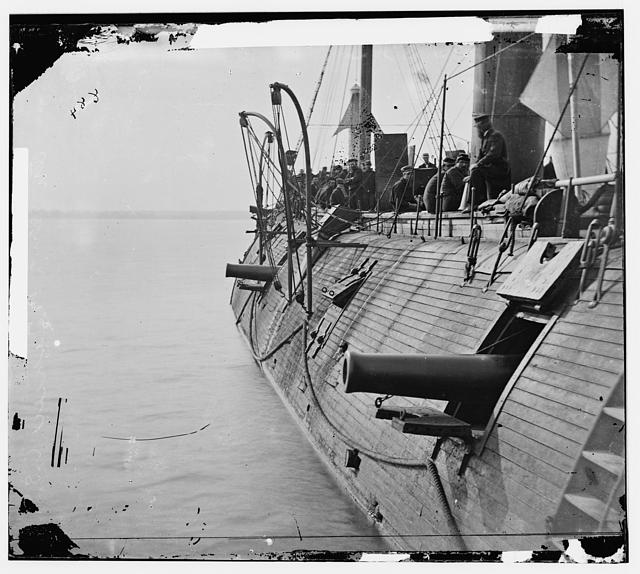By Diana Moraco
On February 14, 1862, the first seagoing ironclad warship of the United States Navy was launched in Mystic, Connecticut. The debut of the USS Galena in the midst of the Civil War (1861-1865) marked the emergence of a new type of naval architecture. It also heralded a shift in naval warfare that resulted from the ingenuity of ironclad designers and the need of the Union for a powerful naval force that could defeat the Confederacy. For Connecticut, the construction of the gunboat Galena broadened the state’s industrial assistance to the Union cause and furthered its overall contributions to the war.
$1.5 million Authorized for Ironclad Warships
In the summer of 1861, Navy Secretary Gideon Welles and businessman Cornelius Scranton Bushnell of New Haven urged Congress to allocate funds for an ironclad construction program to combat the new ironclad vessels of the Confederate Navy. On August 4, 1861, President Abraham Lincoln signed into law $1.5 million in federal funding for the building of ironclad ships.
The Ironclad Board, appointed by Navy Secretary Welles to review incoming ironclad designs, reviewed a total of 17 designs and selected three for construction. The USS New Ironsides was to be built in Philadelphia and the USS Monitor in New York. Bushnell, who had lobbied heavily for Secretary Welles in favor of funding for the ironclads, submitted the design for the Galena by naval architect Samuel H. Pook. After Monitor architect John Ericsson confirmed that the Galena’s design would be sufficient for the Navy’s needs, the Ironclad Board awarded the third contract to Bushnell.
Mystic Shipyard Awarded Contract
With the United States Navy racing to complete its ironclads for battle with the Confederate warships, Bushnell quickly assigned the contract for the Galena to the Mystic shipyard of Maxson, Fish & Company, owned by William Maxson. The construction was a collective effort of industries and businesses. In addition to the Maxson shipbuilding yard, the Reliance Machine Company of Mystic provided the small machine parts for the vessel, while workers from Troy, New York attached the ship’s iron plating.

Mystic-built ironclad Navy Steamship Galena, 1861 – Mystic Seaport and Connecticut History Illustrated
The local newspaper, the Mystic Pioneer, followed construction of the ironclad closely and favorably, reporting on the construction’s fast progress, the large number of people employed on the ship’s construction, and the advantage that the Galena would hold over wooden ships. Expectation for the ship was great; having been produced previously only by Britain and France, ironclads like the Galena signaled a shift in naval architecture that was expected to transform naval operations during the Civil War. Connecticut’s part in constructing the Galena demonstrated Mystic’s strong reputation as a versatile shipbuilding community that could adapt to the Union’s urgent wartime needs.
Less than five months after construction began, and at a cost of $235,250, the 950-ton, 210-foot-long ironclad steamer was launched from the Maxson Company shipyard. According to the Mystic Pioneer and an account from William Maxson, between 1,000 and 2,000 people from Mystic, Norwich, New London, and Stonington were present for the ship’s launching. Afterward, out of fear that the boat would not float due to the heavy iron, the vessel was towed from Mystic to Continental Iron Works in New York for her engine installation and sailing rig fitting. Then the Galena went on to the New York Navy Yard where she received her final iron plating and her commission for the Union Navy. Commissioned on April 21, 1862, The U.S.S. Galena went into immediate service with a crew of 160 men.
Debut Marked by Doubts and Battle Damage

US ironclad Galena, after her attack on Fort Darling, 1862 – Library of Congress, Prints and Photographs Division
Despite local support for the Galena and national excitement over the ironclad, many were unenthusiastic about the new warship, including the ship’s commander, John Rodgers. Commander Rodgers, the son of a War of 1812 hero with the same name, came to the Galena having spent the first part of the Civil War on the Union’s South Atlantic Blockading Squadron, and he feared the Galena’s iron armor was inferior. Still, General George McClellan was waiting for the Galena to assist in his military campaign for Richmond, and on May 8, 1862, Commander Rodgers directed the Galena up Virginia’s James River toward the Confederate capital.
On May 15, eight miles from Fort Darling, Richmond, at the Battle of Drewry’s Bluff, the Galena’s strength as an ironclad was tried by Confederate gunfire. Her iron armor was pierced several times, proving to be far from shot-proof. The Monitor, also present at the standoff, was unable to provide any defense of the Galena. After more than three hours in battle at Drewry’s Bluff, 13 men aboard the Galena were dead and 11 were wounded. The damages sustained by the vessel led her to be branded as a failed ironclad—the only one of the three original ironclads to be unsuccessful. In Connecticut, William Maxson wrote only briefly in his diary of the Galena’s excursion up the James River, and after the event the Mystic Pioneer ceased to mention the ship.
The Galena Fights On
In 1863 the Galena was stripped of her iron plating and refitted as a wooden gunboat. Though she failed in ironclad form, the Galena made a respectable showing in Admiral David Farragut’s fleet in 1864 during the Battle of Mobile Bay in Alabama. The U.S.S. Galena was decommissioned in June of 1865 and finally broken up in 1872 at the Norfolk Navy Yard in Portsmouth, Virginia.

Hull of Mystic-built ironclad Navy steamship Galena showing damage, 1862 – Mystic Seaport and Connecticut History Illustrated
Although the Galena failed to accomplish what was expected of her as an ironclad, the ship symbolized the beginnings of a new type of naval construction for the United States and served as a lesson for the design of future ironclad ships. In Connecticut, the selection of a Mystic shipyard to construct the Galena served to recognize the great industrial success that shipbuilding had become within the state as well as the value of Connecticut as a significant contributor to the Union war cause.
Diana Moraco received her Master’s degree in Public History from Central Connecticut State University and is currently the Membership Coordinator at the Steamship Historical Society of America in Providence, RI.









